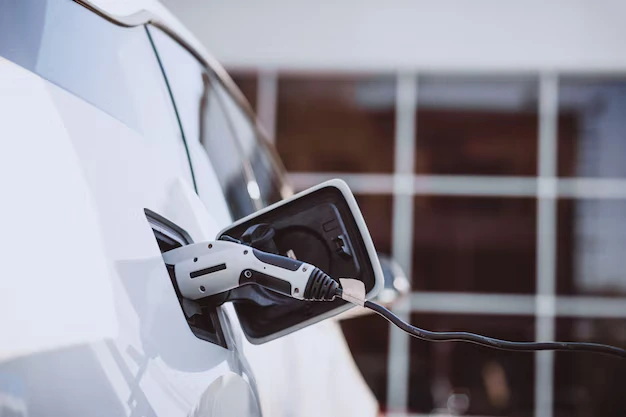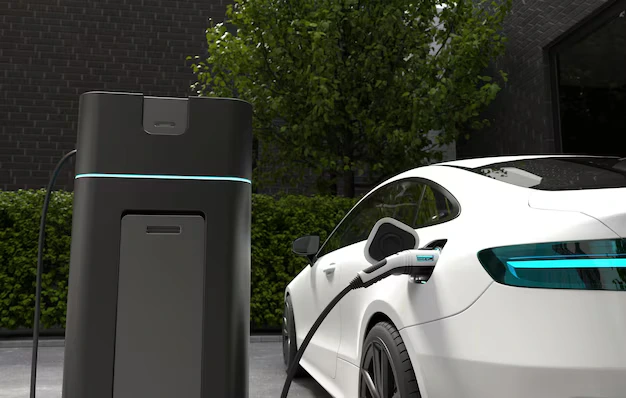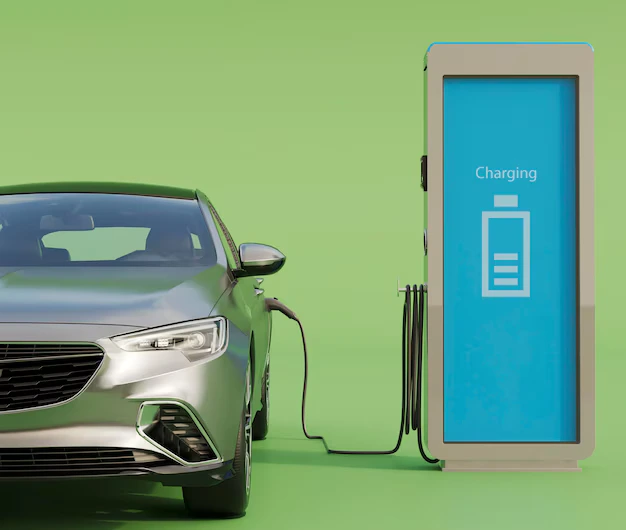The way people travel is changing. Electric vehicles (EVs) are becoming more popular because they help the environment, save money, and are part of the green tech movement. Green tech focuses on technologies that reduce environmental impact, and EVs are leading the way. By running on electricity instead of gasoline, they offer a cleaner, more energy-efficient choice. In this blog, we’ll explore how EVs are changing transportation, the current EV market, and how governments are supporting EV adoption.
What is EV?

Electric vehicles (EVs) are cars powered by electricity rather than gasoline. These cars have an electric motor that runs on batteries. You charge the batteries by plugging the car into an outlet, either at home or at a public station. Unlike regular cars, EVs don’t release harmful gases that pollute the air. This makes them much better for the environment. EVs are a key part of the green tech movement. It focuses on technologies that reduce environmental impact and promote sustainability. By offering a cleaner, energy-efficient option for transportation. EVs play an important role in the future of green tech.
The Environmental Benefits of EVs
- Less Pollution: Gas-powered cars release harmful gases like carbon dioxide (CO2), which are bad for the planet. EVs don’t produce these gases, making them cleaner for the Earth.
- Cleaner Energy: Even if some electricity comes from coal or other non-renewable sources, EVs still cause less pollution than gasoline cars. As more clean energy sources like wind and solar power are used, EVs will be even greener.
- Better Air Quality: EVs don’t have tailpipe emissions, which means they help improve the air quality in cities. This makes the air cleaner and healthier to breathe, especially in areas with a lot of traffic.
Economic Benefits of Electric Vehicles
- Lower Fuel Costs: Charging an EV costs less than buying gasoline. While the cost of electricity varies, it is usually cheaper than fuel, which helps drivers save money over time.
- Less Maintenance: EVs are simpler than gas-powered cars. There’s no need to change the oil or fix exhaust systems. This means fewer visits to the mechanic and lower maintenance costs.
- Financial Incentives: Many governments offer incentives to make EVs more affordable. These include tax rebates, credits, and discounts. These programs help reduce the cost of EVs for buyers.
- Green Tech- EV’s also supports green tech by reducing pollution. Ev’s are charged by battery so there is no more unwanted use of petroleum. It leads to a green tech future.
A Quieter and Smoother Ride
- Less Noise: Gas-powered cars are often noisy, but EVs are much quieter, providing a more peaceful ride. As part of green tech, EVs help reduce noise pollution in cities, contributing to a cleaner environment.
- Smooth Driving: EVs don’t need to shift gears like regular cars. This makes driving smooth and easy. Many people find EVs more enjoyable to drive because of the smooth ride and quick acceleration.
- Immediate responsiveness: Select 98 more words to run Humanizer.: Electric motors provide instant torque, meaning they can accelerate quickly from a standstill. This provides a fast and responsive driving experience, which many drivers enjoy.
- Less Vibration: Since electric motors have fewer moving parts than gas engines, EVs experience less vibration. This creates a more comfortable ride, with fewer bumps and shakes, making the driving experience smoother overall.
The Range of Electric Vehicles is Improving
- Better Battery Life: In the past, one of the main concerns about EVs was their driving range. People worried that the battery wouldn’t last long enough for a road trip. Today, many EVs can travel more than 200 miles on a single charge. This makes EVs more practical for both daily driving and longer trips.
- Charging Stations Are More Common: More and more charging stations are being built around the world. Some stations can charge an EV to 80% in just 30 minutes, which makes long trips easier and faster.
- Longer Range with New Models: Newer models of EVs are offering even greater ranges. Some premium EVs now offer ranges of over 300 miles per charge, allowing drivers to go even further without worrying about recharging.
- Fast Charging Technology: Fast-charging technology is improving rapidly. Some newer charging stations can recharge a vehicle’s battery to 80% in as little as 20 minutes. This reduces wait time, making it easier for drivers to quickly get back on the road during long journeys.
- Home Charging Options: Many EV owners can install home charging stations, making it easier to keep their cars charged overnight. This means drivers don’t have to rely on public stations for daily charging and can start each day with a full battery.
The Current Market for Electric Vehicles

- More Choices: The market for EVs is growing quickly. More car brands are now making EVs, and there are many types available, such as sedans, SUVs, and trucks. This gives consumers more choices to find the car that fits their needs.
- Lower Prices: The price of EVs has dropped in recent years. As more people buy EVs, car companies are able to make them more affordable. This makes EVs more accessible to a wider range of people.
- Increased Popularity: EVs are becoming more popular every year. As concerns about pollution and fuel prices rise, more people are looking for cleaner and cheaper options. This trend is expected to keep growing.
- Better Battery Technology: Advances in battery technology have helped increase the range and efficiency of EVs. Modern EV batteries last longer and charge faster, which makes owning an EV more convenient and practical for a wider range of drivers.
- Wider Charging Infrastructure: The number of charging stations is expanding, making it easier for people to charge their EVs. This growth in charging infrastructure helps address one of the biggest concerns about the availability of charging stations.
- More Affordable Options for Different Budgets: Car manufacturers are now offering EVs at different price points, making electric vehicles accessible to a larger group of buyers. Budget-friendly models alongside high-end options allow consumers from all income levels to consider making the switch to EVs and green tech future.
Government Incentives and Policies to Encourage EV Adoption
- Tax Credits and Rebates: Many governments offer financial help to people who buy EVs, as it can lead to green tech future. This can include tax credits, rebates, and discounts. These programs make EVs more affordable for buyers.
- Lower Taxes on EVs: In many places, EV owners pay lower taxes than those who own gas-powered cars. This helps people save money and makes EVs more appealing.
- Free Parking and Charging: Some cities offer free parking and free charging stations for EV owners. This makes owning an EV even more convenient and cost-effective. With the growth of green tech, more cities are adding these benefits.
- Setting EV Goals: Many countries have set goals to increase the number of EVs on the road. Some countries have even set dates to stop selling new gasoline cars by 2030 or 2040. These goals help push the shift toward cleaner transportation.
- Building Charging Stations: Governments are working to make charging stations more widely available. As more charging stations are built, it will be easier for drivers to find a place to charge their EVs, especially on long trips. add in this too 2-3 times
Challenges for Electric Vehicle Adoption

- High Initial Costs: Even with government incentives, EVs can still be expensive to buy. The upfront cost is higher than a regular car, which can be a barrier for some people, even though they save money in the long run. However, as green tech advances, the cost of EVs is expected to continue to decrease over time, making them more affordable for everyone.
- Limited Charging Stations in Some Areas: In some regions, there may not be enough charging stations. This can make it difficult for people to own an EV, especially in rural areas. However, as green tech expands, more charging stations are being built every day, improving convenience for EV owners everywhere.
- Range Anxiety: Some drivers worry about running out of battery power before they find a charging station. This fear, known as “range anxiety,” is becoming less of a concern as EVs with longer ranges are introduced and more charging stations are built. With advances in green tech, these issues are being addressed, making EVs a more reliable option.
Conclusion
Electric vehicles (EVs) are changing the way people think about transportation. They are better for the environment and provide a smoother driving experience. EVs are a key part of the green tech movement, offering a cleaner, more sustainable option compared to traditional gas-powered cars. While challenges such as high prices and limited charging stations remain, the benefits of EVs are clear. Governments around the world are helping people make the switch by offering incentives and expanding charging infrastructure. As the market for EVs grows and technology improves, electric vehicles will play a major role in creating a cleaner, greener future. The shift to EVs is happening now, and it is helping build a more sustainable world for tomorrow.



